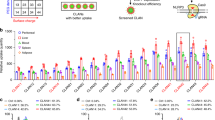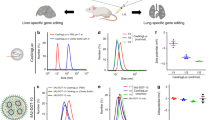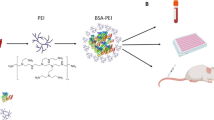Abstract
B cells exert multiple effector functions, and dysfunctions of B cells often lead to initiation and progression of diseases, including autoimmune and inflammatory diseases. Therefore, B cell intervention may be an effective strategy to treat diseases involving B cells. The clustered regularly interspaced short palindromic repeats (CRISPR)-Cas9 gene editing system has been widely used for DNA deletion, insertion, and replacement. Nanocarriers have been developed as relatively mature systems and may be applied to deliver the CRISPR-Cas9 system to B cells in vivo. In this study, we created a library of nanoparticles (NPs) with different polyethylene glycol densities and zeta potentials and screened an optimal NP for in vivo B cell targeting. The selected NP could deliver the CRISPR-Cas9 system to B cells and induce Cas9 expression inside the cell environment. Injection of the NP encapsulated with Cas9/gB220 (NPCas9/gB220) into mice could disrupt B220 expression in B cells, suggestive of its applications to intervene the expression of the target molecule in B cells. Moreover, the treatment with NPCas9/gBAFFR could decrease the number of B cells and exert therapeutic effect in rheumatoid arthritis, as B-cell activating factor receptor (BAFFR) is vital for the survival and functions of B cells. In conclusion, we developed a carrier for the delivery of the CRISPR-Cas9 gene editing system for B cell intervention that could be used for the treatment of diseases related to B cell dysfunctions.

Similar content being viewed by others
References
Claes, N.; Fraussen, J.; Stinissen, P.; Hupperts, R.; Somers, V. B cells are multifunctional players in multiple sclerosis pathogenesis: Insights from therapeutic interventions. Front. Immunol. 2015, 6, 642.
Rawlings, D. J.; Metzler, G.; Wray-Dutra, M.; Jackson, S. W. Altered B cell signalling in autoimmunity. Nat. Rev. Immunol. 2017, 17, 421–436.
Larche, M.; Akdis, C. A.; Valenta, R. Immunological mechanisms of allergen-specific immunotherapy. Nat. Rev. Immunol. 2006, 6, 761–771.
Honigberg, L. A.; Smith, A. M.; Sirisawad, M.; Verner, E.; Loury, D.; Chang, B.; Li, S.; Pan, Z. Y.; Thamm, D. H.; Miller, R. A. et al. The bruton tyrosine kinase inhibitor PCI-32765 blocks B-cell activation and is efficacious in models of autoimmune disease and B-cell malignancy. Proc. Natl. Acad. Sci. USA 2010, 107, 13075–13080.
Herman, S. E. M.; Gordon, A. L.; Hertlein, E.; Ramanunni, A.; Zhang, X.; Jaglowski, S.; Flynn, J.; Jones, J.; Blum, K. A.; Buggy, J. J. et al. Bruton tyrosine kinase represents a promising therapeutic target for treatment of chronic lymphocytic leukemia and is effectively targeted by PCI-32765. Blood 2011, 117, 6287–6296.
Di Paolo, J. A.; Huang, T.; Balazs, M.; Barbosa, J.; Barck, K. H.; Bravo, B. J.; Carano, R. A. D.; Darrow, J.; Davies, D. R.; DeForge, L. E. et al. Specific Btk inhibition suppresses B cell- and myeloid cell-mediated arthritis. Nat. Chem. Biol. 2011, 7, 41–50.
Pescovitz, M. D.; Greenbaum, C. J.; Krause-Steinrauf, H.; Becker, D. J.; Gitelman, S. E.; Goland, R.; Gottlieb, P. A.; Marks, J. B.; McGee, P. F.; Moran, A. M. et al. Rituximab, B-lymphocyte depletion, and preservation of beta-cell function. N. Engl. J. Med. 2009, 361, 2143–2152.
Edwards, J. C. W.; Szczepanski, L.; Szechinski, J.; Filipowicz- Sosnowska, A.; Emery, P.; Close, D. R.; Stevens, R. M.; Shaw, T. Efficacy of B-cell-targeted therapy with rituximab in patients with rheumatoid arthritis. N. Engl. J. Med. 2004, 350, 2572–2581.
Kardava, L.; Moir, S.; Wang, W.; Ho, J.; Buckner, C. M.; Posada, J. G.; O’Shea, M. A.; Roby, G.; Chen, J.; Sohn, H. W. et al. Attenuation of HIV-associated human B cell exhaustion by siRNA downregulation of inhibitory receptors. J. Clin. Invest. 2011, 121, 2614–2624.
Doudna, J. A.; Charpentier, E. The new frontier of genome engineering with CRISPR-Cas9. Science 2014, 346, 1258096.
Chu, V. T.; Graf, R.; Wirtz, T.; Weber, T.; Favret, J.; Li, X.; Petsch, K.; Tran, N. T.; Sieweke, M. H.; Berek, C. et al. Efficient CRISPR-mediated mutagenesis in primary immune cells using CrispRGold and a C57BL/6 Cas9 transgenic mouse line. Proc. Natl. Acad. Sci. USA 2016, 113, 12514–12519.
Cheong, T. C.; Compagno, M.; Chiarle, R. Editing of mouse and human immunoglobulin genes by CRISPR-Cas9 system. Nat. Commun. 2016, 7, 10934.
Pogson, M.; Parola, C.; Kelton, W. J.; Heuberger, P.; Reddy, S. T. Immunogenomic engineering of a plug-and-(dis)play hybridoma platform. Nat. Commun. 2016, 7, 12535.
Wang, H. X.; Li, M. Q.; Lee, C. M.; Chakraborty, S.; Kim, H. W.; Bao, G.; Leong, K. W. CRISPR/Cas9-based genome editing for disease modeling and therapy: Challenges and opportunities for nonviral delivery. Chem. Rev. 2017, 117, 9874–9906.
Sun, W. J.; Ji, W. Y.; Hall, J. M.; Hu, Q. Y.; Wang, C.; Beisel, C. L.; Gu, Z. Self-assembled DNA nanoclews for the efficient delivery of CRISPR-Cas9 for genome editing. Angew. Chem., Int. Ed. 2015, 54, 12029–12033.
Yin, H.; Song, C. Q.; Dorkin, J. R.; Zhu, L. H. J.; Li, Y. X.; Wu, Q. Q.; Park, A.; Yang, J.; Suresh, S.; Bizhanova, A. et al. Therapeutic genome editing by combined viral and non-viral delivery of CRISPR system components in vivo. Nat. Biotechnol. 2016, 34, 328–333.
Li, L.; Song, L. J.; Liu, X. W.; Yang, X.; Li, X.; He, T.; Wang, N.; Yang, S.; Yu, C.; Yin, T. et al. Artificial virus delivers CRISPR-Cas9 system for genome editing of cells in mice. ACS Nano 2017, 11, 95–111.
Almeida, J. P.; Lin, A. Y.; Langsner, R. J.; Eckels, P.; Foster, A. E.; Drezek, R. A. In vivo immune cell distribution of gold nanoparticles in naïve and tumor bearing mice. Small 2014, 10, 812–819.
Song, E.; Zhu, P. C.; Lee, S. K.; Chowdhury, D.; Kussman, S.; Dykxhoorn, D. M.; Feng, Y.; Palliser, D.; Weiner, D. B.; Shankar, P. et al. Antibody mediated in vivo delivery of small interfering RNAs via cell-surface receptors. Nat. Biotechnol. 2005, 23, 709–717.
McNamara, J. O.; Andrechek, E. R.; Wang, Y.; Viles, K. D.; Rempel, R. E.; Gilboa, E.; Sullenger, B. A.; Giangrande, P. H. Cell type-specific delivery of siRNAs with aptamer-siRNA chimeras. Nat. Biotechnol. 2006, 24, 1005–1015.
Rozema, D. B.; Lewis, D. L.; Wakefield, D. H.; Wong, S. C.; Klein, J. J.; Roesch, P. L.; Bertin, S. L.; Reppen, T. W.; Chu, Q. L.; Blokhin, A. V. et al. Dynamic polyconjugates for targeted in vivo delivery of siRNA to hepatocytes. Proc. Natl. Acad. Sci. USA 2007, 104, 12982–12987.
Yu, K. T.; Zhou, Y. L.; Li, Y. H.; Sun, X. S.; Sun, F. Y.; Wang, X. M.; Mu, H. Y.; Li, J.; Liu, X. Y.; Teng, L. S. et al. Comparison of three different conjugation strategies in the construction of herceptin-bearing paclitaxel-loaded nanoparticles. Biomater. Sci. 2016, 4, 1219–1232.
Davis, M. E.; Zuckerman, J. E.; Choi, C. H.; Seligson, D.; Tolcher, A.; Alabi, C. A.; Yen, Y.; Heidel, J. D.; Ribas, A. Evidence of RNAi in humans from systemically administered siRNA via targeted nanoparticles. Nature 2010, 464, 1067–1070.
Lv, M. M.; Li, X.; Huang, Y.; Wang, N.; Zhu, X. Y.; Sun, J. Inhibition of fibrous dysplasia via blocking Gsa with suramin sodium loaded with an alendronate-conjugated polymeric drug delivery system. Biomater. Sci. 2016, 4, 1113–1122.
Ashley, C. E.; Carnes, E. C.; Phillips, G. K.; Padilla, D.; Durfee, P. N.; Brown, P. A.; Hanna, T. N.; Liu, J. W.; Phillips, B.; Carter, M. B. et al. The targeted delivery of multicomponent cargos to cancer cells by nanoporous particlesupported lipid bilayers. Nat. Mater. 2011, 10, 389–397.
Keles, E.; Song, Y.; Du, D.; Dong, W. J.; Lin, Y. H. Recent progress in nanomaterials for gene delivery applications. Biomater. Sci. 2016, 4, 1291–1309.
Tenzer, S.; Docter, D.; Kuharev, J.; Musyanovych, A.; Fetz, V.; Hecht, R.; Schlenk, F.; Fischer, D.; Kiouptsi, K.; Reinhardt, C. et al. Rapid formation of plasma protein corona critically affects nanoparticle pathophysiology. Nat. Nanotechnol. 2013, 8, 772–781.
Voigt, J.; Christensen, J.; Shastri, V. P. Differential uptake of nanoparticles by endothelial cells through polyelectrolytes with affinity for caveolae. Proc. Natl. Acad. Sci. USA 2014, 111, 2942–2947.
Carven, G. J.; Chitta, S.; Hilgert, I.; Rushe, M. M.; Baggio, R. F.; Palmer, M.; Arenas, J. E.; Strominger, J. L.; Horejsi, V.; Santambrogio, L. et al. Monoclonal antibodies specific for the empty conformation of HLA-DR1 reveal aspects of the conformational change associated with peptide binding. J. Biol. Chem. 2004, 279, 16561–16570.
De Koker, S.; Cui, J. W.; Vanparijs, N.; Albertazzi, L.; Grooten, J.; Caruso, F.; De Geest, B. G. Engineering polymer hydrogel nanoparticles for lymph node-targeted delivery. Angew. Chem., Int. Ed. 2016, 55, 1334–1339.
Mueller, S. N.; Tian, S. M.; DeSimone, J. M. Rapid and persistent delivery of antigen by lymph node targeting PRINT nanoparticle vaccine carrier to promote humoral immunity. Mol. Pharmaceutics 2015, 12, 1356–1365.
Chang, T. Z.; Stadmiller, S. S.; Staskevicius, E.; Champion, J. A. Effects of ovalbumin protein nanoparticle vaccine size and coating on dendritic cell processing. Biomater. Sci. 2017, 5, 223–233.
Yang, X. Z.; Dou, S.; Sun, T. M.; Mao, C. Q.; Wang, H. X.; Wang, J. Systemic delivery of siRNA with cationic lipid assisted PEG-PLA nanoparticles for cancer therapy. J. Control. Release 2011, 156, 203–211.
Zhu, K. J.; Lin, X. Z.; Yang, S. L. Preparation, characterization, and properties of polylactide (PLA) poly(ethylene glycol) (PEG) copolymers: A potential-drug carrier. J. Appl. Poly. Sci. 1990, 39, 1–9.
Du, X. J.; Wang, J. L.; Liu, W. W.; Yang, J. X.; Sun, C. Y.; Sun, R.; Li, H. J.; Shen, S.; Luo, Y. L.; Ye, X. D. et al. Regulating the surface poly(ethylene glycol) density of polymeric nanoparticles and evaluating its role in drug delivery in vivo. Biomaterials 2015, 69, 1–11.
Wang, H. X.; Zuo, Z. Q.; Du, J. Z.; Wang, Y. C.; Sun, R.; Cao, Z. T.; Ye, X. D.; Wang, J. L.; Leong, K. W.; Wang, J. Surface charge critically affects tumor penetration and therapeutic efficacy of cancer nanomedicines. Nano Today 2016, 11, 133–144.
Mackay, F.; Schneider, P. Cracking the BAFF code. Nat. Rev. Immunol. 2009, 9, 491–502.
Edwards, J. C. W.; Cambridge, G. B-cell targeting in rheumatoid arthritis and other autoimmune diseases. Nat. Rev. Immunol. 2006, 6, 394–403.
Sanz, I.; Lee, F. E. H. B cells as therapeutic targets in SLE. Nat. Rev. Rheumatol. 2010, 6, 326–337.
Mariño, E.; Silveira, P. A.; Stolp, J.; Grey, S. T. B celldirected therapies in type 1 diabetes. Trends Immunol. 2011, 32, 287–294.
Brightbill, H. D.; Jeet, S.; Lin, Z. H.; Yan, D. H.; Zhou, M. J.; Tan, M.; Nguyen, A.; Yeh, S.; Delarosa, D.; Leong, S. R. et al. Antibodies specific for a segment of human membrane IgE deplete IgE-producing B cells in humanized mice. J. Clin. Invest. 2010, 120, 2218–2229.
Noy, R.; Pollard, J. W. Tumor-associated macrophages: From mechanisms to therapy. Immunity 2014, 41, 49–61.
Morvan, M. G.; Lanier, L. L. NK cells and cancer: You can teach innate cells new tricks. Nat. Rev. Cancer 2016, 16, 7–19.
Talukdar, S.; Oh, D. Y.; Bandyopadhyay, G.; Li, D. M.; Xu, J. F.; McNelis, J.; Lu, M.; Li, P. P.; Yan, Q. Y.; Zhu, Y. M. et al. Neutrophils mediate insulin resistance in mice fed a high-fat diet through secreted elastase. Nat. Med. 2012, 18, 1407–1412.
Li, M.; Sun, R.; Xu, L.; Yin, W. W.; Chen, Y. Y.; Zheng, X. D.; Lian, Z. X.; Wei, H. M.; Tian, Z. G. Kupffer cells support hepatitis B virus-mediated CD8+ T cell exhaustion via hepatitis B core antigen-TLR2 interactions in mice. J. Immunol. 2015, 195, 3100–3109.
Fugger, L.; Friese, M. A.; Bell, J. I. From genes to function: The next challenge to understanding multiple sclerosis. Nat. Rev. Immunol. 2009, 9, 408–417.
Lehuen, A.; Diana, J.; Zaccone, P.; Cooke, A. Immune cell crosstalk in type 1 diabetes. Nat. Rev. Immunol. 2010, 10, 501–513.
Acknowledgements
This work was supported by the National Key R&D Program of China (No. 2017YFA0205600), the National Basic Research Program of China (No. 2015CB932100), the National Natural Science Foundation of China (Nos. 551390482 and 51633008), the China Postdoctoral Science Foundation (Nos. 2016M590582 and 2018M630953), and the Fundamental Research Funds for the Central Universities.
Author information
Authors and Affiliations
Corresponding authors
Electronic supplementary material
Rights and permissions
About this article
Cite this article
Li, M., Fan, YN., Chen, ZY. et al. Optimized nanoparticle-mediated delivery of CRISPR-Cas9 system for B cell intervention. Nano Res. 11, 6270–6282 (2018). https://doi.org/10.1007/s12274-018-2150-5
Received:
Revised:
Accepted:
Published:
Issue Date:
DOI: https://doi.org/10.1007/s12274-018-2150-5




